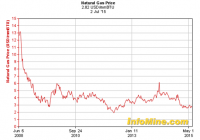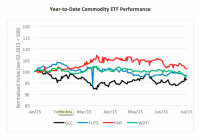
Summary The company’s long-term story remains unchanged and highly favorable. The recent sell-off likely the result of sector rotation out of utilities. I increased my exposure to the shares by 50%. Calpine Corporation (NYSE: CPN ) shares have gotten pummeled in recent months and now sit at 52 week lows near $17.50/share. Shares are down significantly since I first recommended the company on Seeking Alpha back in February of 2015 , but I still maintain a long-term bullish outlook. This is one company that I agree with sell-side analysts on and I’ve been vigorously beating the drum in favor of. In my opinion, there isn’t a company better positioned for macro trends in United States energy production over the next ten-twenty years than Calpine. This is a shame as retail investors have shunned the company, with the almost all of the shares held by insiders or institutions. This is woeful compared to peers and I think retail investors are turning a blind eye to the company’s prospects for capital appreciation. The lack of a dividend, as opposed to the company’s share repurchase plan, in my opinion is the single biggest obstacle that retail investors need to get over when considering an investment here. Especially for tax-advantaged accounts, Calpine can give utility-sector exposure to improve account diversification while simultaneously providing an excellent growth vehicle long-term. Long-Term Tends Remain Intact Increasingly stringent environmental regulations in the United States are not going away anytime soon, despite heavy lobbying from the coal industry and some outdated utility players. 63% of Americans now believe in climate change according to a recent Yale study on the subject. Such a large voting bloc can’t be ignored going forward and any attempts to strip down/repeal current EPA mandates are likely to be met with fierce voter opposition. Unfortunately the facts remain that America’s coal fleet is incredibly old; the average coal-fired power plant was constructed in the 1970’s. Bolt-on fixes to reduce greenhouse gas emissions on these plants are going to become increasingly more expensive and subject to diminishing returns. On the same coin, new construction of coal plants, which are highly capital intensive and require decades for payoff, are unlikely in the current regulatory environment regulating CO2 and other gases. Likewise, we aren’t shutting off coal and switching to wind/solar/hydroelectric overnight. We simply don’t have the technological capacity or the investable capital to meet our current energy needs with these processes yet. Renewable energy’s share of power generation is highly likely to continue growing quickly over the coming years, but the time when renewables constitute the majority of American power generation is likely many decades away. * Historical natural gas price chart 2008-2015 By comparison, plants fired by natural gas, which constituted 95% of Calpine’s power generation in 2014, are set to the biggest beneficiaries of the production switch. Cheap natural gas from the American shale revolution likely isn’t going away anytime soon and will continue to be an amazing source of cheap power input for natural gas plants. While fracking is also a highly contentious environmental issue, opinion is more divided here than with opinions on the coal industry and climate change and may be symptomatic of a lack of understanding of the process rather than the actual science behind it. A federal ban or hamstringing regulation is highly unlikely at this point and states where fracking occurs are treading carefully given the boost the process has given local economies. Reducing Debt, Freeing Up Cash flow Calpine holds a stigma after dealing with a bankruptcy in 2005. Natural gas prices were sky-high, competition was stiff with new plants coming online the company’s markets, and the company’s $22B debt load was simply unsustainable. The company now has more assets than it did pre-bankruptcy and the debt load much smaller at $11.84B, so investors should not have little fear of a repeat. * Calpine Investor Presentation Additionally, average yearly interest expense has come down significantly during this timeframe, saving the company hundreds of millions over the past few years as the company takes advantage of the low interest rate environment. As the debt comes down over the next few years, this frees up capital for the company to continue to purchase shares at an elevated rate or invest in new acquisitions that will generate substantial additional earnings (like the Fore River purchase from Exelon in August of 2014). 1Q 2015 Results, Rest-Of-Year Outlook First quarter was in-line with management guidance. This sported a tough year/year comparable because of the polar vortex, which provided an extremely healthy boost to first quarter results last year (adjusted EBITDA in the east region was down from $269M to $125M y/y). Of note is management’s reaffirmation of 2015 adjusted EBITDA (basically EBITDA plus debt extinguishment, one-off maintenance, operating leases, and stock-based compensation) of $1.9-2.1B. For investors used to EBITDA, EBITDA is forecast to be $1.5-$1.7B. This places estimates of 2016 EV/EBITDA firmly in the 10-11x range, which is honestly in-line with broader market peers. The difference here is this is severely discounting Calpine’s advantages. Its fleet is young (average plant age of 14 years), giving the company an advantage over aging peers. As we’ve noted, it has no projected expensive regulatory overhang from EPA emission mandates. It operates in some of the strongest power markets in the United States (California, Texas, and the Northeast). Of note are the share repurchases. Total spent on repurchases totaled $236M through 4/30/15. Pushing this through the rest of the year (although perhaps management may elevate purchases due to lower prices at current levels) and it is likely that Calpine will retire $700M+ worth of shares at current rates. If prices remain at current levels, this could end up retiring 10%+ of the float in one year, just from free cash flow (free cash flow for 2015 is projected at between $800-$1B). Conclusion Calpine remains a strong buy and I’m unsure of what has driven the current selloff other than sector rotation, which has been a driving theme of 2015 as utilities have swung out-of-favor due to the impacts of a looming fed rate hike, which impacts utilities in regards to value of the dividend yield (no impact on Calpine as it pays no dividend) and the possibility of higher interest costs (approximately 50% of Calpine’s debt is variable rate, generally tied to LIBOR + a fixed rate). Most investors would be well-suited to include Calpine in their investments, especially younger investors that have a long timeframe to allow the secular trends to play out in the company’s favor. Even short-term traders may be interested, given the company is going to perform strongly in the back half of the year where it traditionally has not, giving the company an opportunity to trounce year/year comparables. Disclosure: I am/we are long CPN. (More…) I wrote this article myself, and it expresses my own opinions. I am not receiving compensation for it (other than from Seeking Alpha). I have no business relationship with any company whose stock is mentioned in this article.

